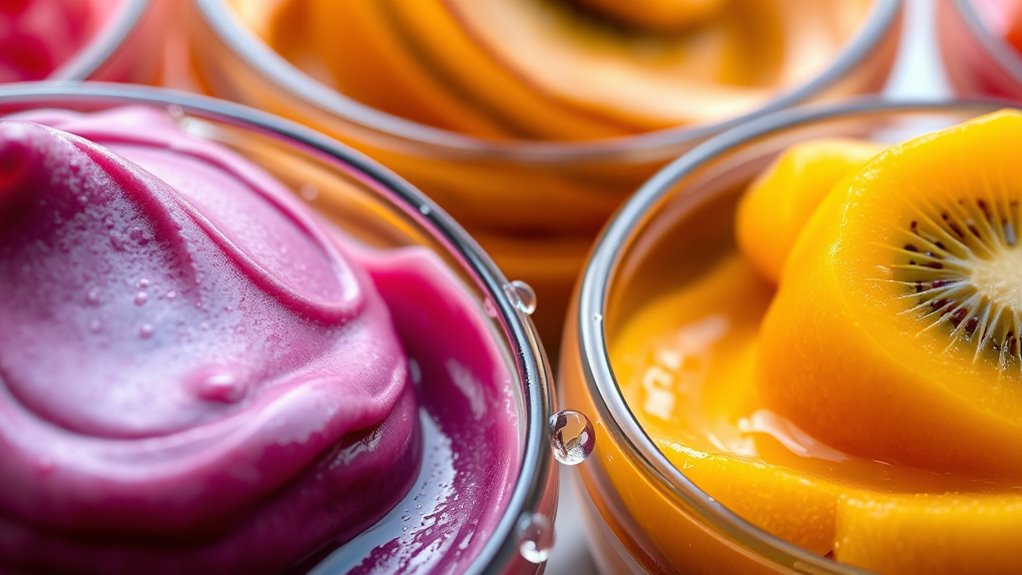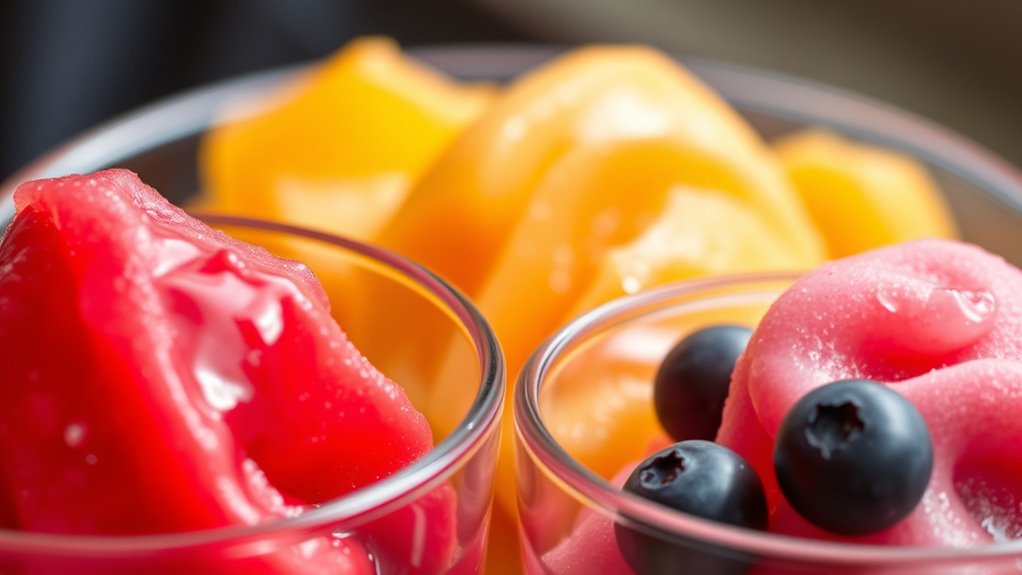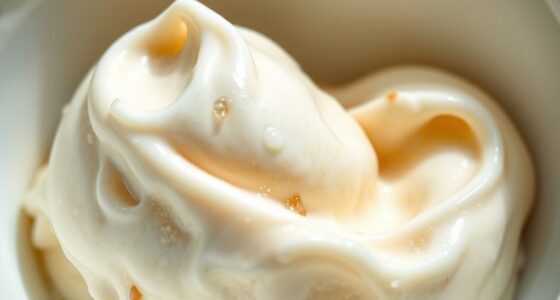The pH level in your fruit gelati is more important than you might realize because it impacts texture, flavor, and safety. When you control acidity with ingredients like lemon juice or citric acid, you prevent undesirable flavors and guarantee a smooth, creamy consistency. Proper pH also inhibits microbial growth, extending shelf life. If you keep an eye on pH, you’ll produce a tastier, safer gelati with better stability—learn more to perfect your process.
Key Takeaways
- pH controls the texture, ensuring a smooth, creamy consistency in fruit gelati.
- Proper pH levels inhibit microbial growth, extending shelf life and ensuring safety.
- pH balance influences flavor by preventing undesirable tartness or off-flavors.
- Maintaining optimal pH stabilizes proteins, reducing ice crystal formation for better texture.
- Accurate pH regulation preserves product quality and consistency during storage.

Understanding the pH balance in fruit gelati is essential because it directly affects the texture, flavor, and shelf life of the product. When you’re making gelati, maintaining proper pH levels isn’t just a minor detail—it’s a critical factor that influences how your final product turns out. If the pH is too high or too low, you risk developing undesirable textures, off-flavors, or even safety issues. That’s why you need to pay close attention to acidity, especially when it comes to acidic preservation and pH regulation techniques.
Fruit naturally varies in acidity, but adding ingredients like citric acid or lemon juice allows you to control the pH more precisely. Acidic preservation is a common method used in gelati making because it helps inhibit microbial growth, extending shelf life without relying on artificial preservatives. When you regulate the pH properly, you create an environment that’s inhospitable to bacteria and molds, keeping your gelati fresh longer. To do this effectively, you should regularly test the pH with a reliable pH meter or strips during the production process. This way, you can make adjustments on the fly, ensuring the pH stays within the ideal range—usually between 3.0 and 4.0 for fruit gelati.
Using pH regulation techniques isn’t complicated, but it does require some knowledge and precision. Start by measuring the natural pH of your fruit purees before blending them into your gelati base. If the acidity isn’t enough to ensure safety and stability, you can add small amounts of acids gradually, mixing thoroughly and retesting until you hit the target pH. This process helps balance flavor and safety without compromising the natural fruit taste. Remember, too much acid can make your gelati overly tart, so moderation is key. Additionally, understanding the role of contrast ratio in maintaining a desirable texture can be helpful, as pH influences protein stability and ice crystal formation.
Beyond safety, pH also influences the gelati’s texture. A balanced pH helps maintain a smooth, creamy consistency by stabilizing the proteins and preventing ice crystal formation. This results in a more refined mouthfeel that customers appreciate. In short, understanding and controlling pH through proper acidic preservation and pH regulation techniques not only prolongs shelf life but also enhances flavor and texture. Paying attention to these details allows you to craft high-quality, delicious fruit gelati that stand out in both taste and safety.
Frequently Asked Questions
How Does Ph Affect the Shelf Life of Fruit Gelati?
You might not realize it, but pH directly impacts the shelf life of fruit gelati. Maintaining proper pH balance guarantees acidity control, which inhibits bacterial growth and mold. When the pH is too high or too low, your gelati’s freshness decreases quickly. By carefully managing acidity levels, you extend shelf life and keep your fruit gelati tasting fresh longer. Proper pH management is essential for quality and safety.
Can Adjusting Ph Improve Gelati Flavor Stability?
Did you know that adjusting pH can boost flavor stability by up to 30%? When you tweak pH levels in fruit gelati, you actively improve flavor preservation and maintain texture consistency longer. This means your gelati stays fresher and tastier, reducing spoilage and ensuring customer satisfaction. By paying attention to pH, you take control of your product’s quality, making it more appealing and consistent every time.
What Ph Levels Are Ideal for Different Fruit Types?
You should aim for specific pH levels to enhance fruit-based gelati flavor stability, depending on the fruit’s acidity. For citrus fruits, keep pH around 3.0-3.5, while berries thrive at pH 2.9-3.2. Apples and peaches prefer slightly higher pH, around 3.4-3.6. Proper pH calibration balances acidity, preserves flavor, and prevents spoilage. Adjusting pH based on fruit type ensures ideal gelati quality and consistency.
How Does Ph Influence the Texture of Gelati?
You see, pH balance directly impacts the texture of gelati. When the pH is too low or high, it can cause the gelati to become either too icy or too sticky. Maintaining the right pH guarantees proper texture enhancement, making the gelati smooth and creamy. By controlling pH levels, you can achieve a desirable consistency that highlights the fruit’s natural flavors and ensures a delightful eating experience.
Are There Natural Methods to Modify Ph in Fruit Gelati?
You can naturally modify pH in fruit gelati through methods like natural fermentation, which introduces beneficial bacteria to lower pH levels. Additionally, using ingredients with high pH buffering capacity, such as dairy or certain fruits, helps stabilize acidity. These natural approaches allow you to adjust pH without artificial additives, improving gelati’s texture and flavor while maintaining a more wholesome product.
Conclusion
Remember, the pH balance in your fruit gelati isn’t just about taste; it’s about preserving quality and safety. When you pay attention to acidity levels, you guarantee a vibrant, fresh experience with every scoop. As the saying goes, “A little caution goes a long way.” By understanding and controlling pH, you’re not just making gelati—you’re crafting a delicious, reliable treat that keeps everyone coming back for more.









